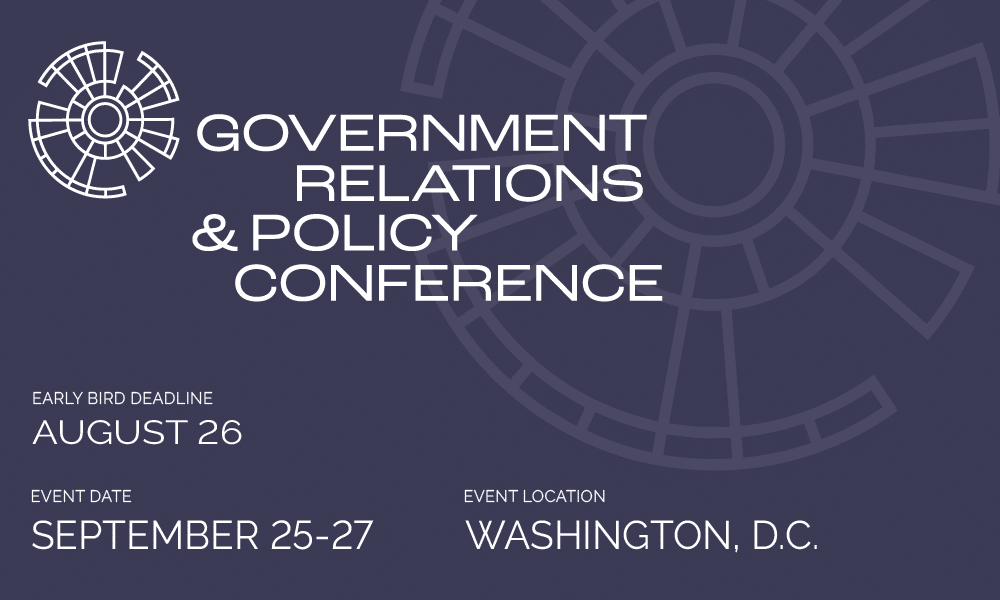When Building a Strong Coalition, Think Beyond the Usual Suspects
July/August 2024
The NDD United coalition was worried. This was in 2010, and Congress was looking to cut budgets as part of the sequestration process. NDD United represented vested stakeholders of nondefense discretionary programs — a diverse array of sectors that would be hit hard by spending cuts.
The coalition was concerned that if the defense sector got an exemption from spending cuts, the remaining cuts would fall even more heavily on their sectors.
Then something unexpected happened. A representative of the Aerospace Industries Association contacted Emily Holubowich, the head of NDD United at the time. “He was a former colleague of mine,” Holubowich says. “And he reached out to me to say, ‘I think what your coalition is doing is really cool. Can you tell me more?’”
As it turned out, the nondefense and defense sectors had many common goals. “For a lot of these companies, the Department of Defense might be their No. 1 contractor, but then the Centers for Disease Control and Prevention or the Department of Transportation is their second biggest,” says Holubowich. “It wasn’t just about their bottom line, either. The defense industries understood that cuts to nondefense spending like health or education would impact the nation’s defense readiness.
“We realized it wasn’t one or the other, defense or nondefense, but that we would rise or fall together.”
Soon after that fateful meeting, the trade association joined the NDD United coalition. Not just joined — it became one of the coalition’s best financial supporters and key partners in getting out the coalition’s message.
The newly expanded coalition was successful in advocating for parity across both sectors. To this day, if nondefense spending is cut, defense spending is cut at the same rate, and vice versa.
The alliance made sense in retrospect, but at the time, the defense sector hadn’t been at the top of Holubowich’s list of possible members of a nondefense discretionary spending coalition. Their shared success proved to be an important lesson in thinking about unusual or “out of the box” coalition partners.
“They were an amazing ally. They opened more doors and added credibility to our cause.”
Why Form a Coalition?
Government relations professionals understand that coalitions are powerful organizing tools. When everyone is fighting for the attention of a handful of decision makers, joining forces as a coalition can help pool finite resources while amplifying your preferred policy solutions. Coalitions can demonstrate broad support for a proposed outcome and remind policymakers what’s at stake and who is affected by their decisions.
The makeup of a coalition can speak as loudly as the coalition’s message. The members of a coalition can highlight the economic impacts, health effects, core values or breadth of support for a given policy outcome.
It’s important to think strategically and creatively about who to invite in, and what that demonstrates to lawmakers.
Round Up the Usual Suspects
Once you’ve decided a coalition is a useful tool to advance your policy preference, you can approach the like-minded sectors or organizations that are already working toward the same outcome. These are the organizations that don’t require a hard sell — they’re familiar with the issue and the policies, you’ve been in all the same meetings, and they’re already talking to the key decision makers.
If you’re just getting started, congressional or administrative staff can be great resources to help you map the key players. Meet with a congressional or administrative champion and ask them who they’re hearing from on the issue. Check the lobbying records to see who is working on this issue.
Once you’ve established the core of the coalition, you can move on to the next tier of membership: the organizations that need to be sold a little harder on the issue.
These are the organizations or sectors that support your proposed solution but might be reluctant to devote any time or resources to it because it’s not an organizational priority. To recruit these organizations, you’ll need to be prepared with the reasons for joining and be able to answer hard questions about what it will cost the organization to affiliate with you — both time and money.
It’s worth bringing these partners along if you can, because they help to demonstrate diversity and strength of the coalition. Think about the gaps or weaknesses in your coalition and seek to fill them with these organizations.
For example, for Erin Morton, who runs the Coalition for Health Funding, it’s important to ensure that the coalition’s membership represents health funding recipients from across all relevant federal agencies. Not just the big players — think Centers for Disease Control (CDC) or National Institutes of Health (NIH) — but the smaller agencies like the Administration for Community Living, the Substance Abuse and Mental Health Services Administration or the Health Resources and Services Administration.
By carefully curating their membership to ensure they’re representing nonprofits that interact with every health-related agency, the coalition demonstrates its expertise in the entire public health sector and speaks with more authority about all the nuances of public health spending.
“CHF advocates for funding across all of HHS,” says Morton. “While larger agencies like CDC and NIH often have more political support, the lesser-known, smaller agencies are just as important to the coalition. We’re not perceived as just caring about one agency over another but rather for advocacy across public health.”
At this point, you’ve gathered the usual suspects. You’re collaborating with the groups that are already working to some extent on your policy solution. You can stop here, or you can dig a bit deeper and reach out to the “unusual suspects” — those unconventional partners that have the potential to add reach and credibility to your issue in unexpected ways.

Finding Unconventional Coalition Partners
Melissa Horn knows a thing or two about unconventional coalition partners, because she has been the unconventional coalition partner.
Horn has worked in government relations for over 20 years, mostly as a health policy advocate. But before her current role as director of state legislative affairs at the Arthritis Foundation, she worked in government relations for the National Association of Realtors, and before that as a health policy advocate in Wisconsin.
If the jump from health to real estate and back to health seems strange, Horn explains, it really wasn’t. During her time advocating for smoke-free housing in Wisconsin, she found herself crossing paths with the real estate and insurance industries — a lot.
While she was approaching smoke-free housing as a public health advocate, the three sectors had a lot in common. Smoking is a fire hazard, and that drives up insurance claims and poses additional liability risk for property owners. Insurance costs are also a primary issue for housing providers as well as commercial and residential real estate organizations. “This is not just a health issue,” she explains. “You can see how the policy angles overlap and why these stakeholders would end up at the same table.”
The eventual alliance formed thanks to a series of conversations Horn had at different conferences. She would be at the booth promoting smoke-free housing, giving away little measuring tapes, and that would spark conversations. These conversations led to an understanding that these three disparate industries all had an interest in smoke-free housing policies.
Horn was also advocating for “Complete Streets” policies, which emphasized walkable neighborhoods. While she was focused on the public health benefits, she found that the Realtors and AARP were stakeholders, too. “The reasons they engage complement the health angle. Property owners and residents of all demographics emphasize safety when considering Complete Streets policies that accommodate multiple modes of transportation. AARP even has a Livability Index that highlights safe and walkable routes to schools, grocery stores and hospitals, and other important considerations in a community that can impact property values.”
Horn’s experiences demonstrate how to find and forge alliances with the more “unconventional” partners. After all, they’re not obvious by definition. It might take a lot more research or analysis to identify who has a common interest in your policy solution. But it can also come down to relationships.
“The networking is critical,” Horn says. “You don’t know who you’ll strike up a conversation with. Just ask what they’re working on or interested in. That’s when you find the commonality. Sometimes it’s a second- or third-tier policy issue for them and they don’t have a lot of opportunity to talk about it. Just by having a conversation, you can find potential partnerships that may be less conventional but can really move the dial for your policy efforts.”
Be Open to the Unexpected
In addition to deep research and a strong network, it’s important to be flexible and open to the unexpected.
When Buffalo Bills safety Damar Hamlin suffered a cardiac arrest on live television in the middle of a football game in 2023, millions of Americans were paying attention. Suddenly, sports players and fans were all talking about heart health. And the NFL wanted to take action.
By that time, Emily Holubowich had moved from NDD United to the American Heart Association. Once again, she received a call from an unconventional partner — this time from Ken Edmonds, the in-house lobbyist for the NFL. He wanted to channel the concern for Hamlin’s cardiac event into real change and policy solutions.
Together, the American Heart Association and the NFL created the “Nation of Lifesavers” campaign, an education initiative that empowers bystanders to save lives. They also joined together to form the Smart Heart Sports Coalition to move policy solutions at the state and federal levels.
The coalition includes all the major sports leagues, public health associations, emergency response providers, and families who lost children due to a lack of public defibrillators or people trained to use them. To gain additional attention, the coalition elevates celebrity spokespeople who have been affected by heart disease, including Star Jones, Susan Lucci and, of course, Damar Hamlin.
This unusual but effective coalition has seen a lot of success moving policy. The Hearts Act, which would fund automated defibrillators in schools and train school staff to use them, is poised for floor action in the House, and a similar bill may soon be considered in the Senate. The coalition is also working on several bills at the state level.
“If it wasn’t for Damar Hamlin bringing national attention to this issue, I don’t know that we would’ve seen this momentum,” Holubowich says.
It Takes Time and Creativity
Building a successful coalition takes time, energy and thoughtfulness. It relies on trust, and trust is earned, especially if you’re bringing together groups that aren’t normally aligned.
But the potential to reach new and broader audiences and build strong support for your cause makes the time and effort worthwhile. Thinking creatively and bringing together organizations, industries and celebrities that might not otherwise be aligned is a powerful message to lawmakers that there is widespread support for your policy issue and that people are paying attention.
“It’s really noisy out there,” says Horn. “If you don’t band together, you won’t be heard.”
Want to learn more about coalition building? We’ll go in-depth on this topic during the Government Relations & Policy Conference, September 25-27, in Washington, D.C.
“
“It might take a lot more research or analysis to identify who has a common interest in your policy solution. But it can also come down to relationships.”
More News & Resources
Whether you’re building cutting-edge campaigns, engaging communities on social, mobilizing advocates, or exploring the power of new AI tools, THIS is where the future of advocacy comes alive.



